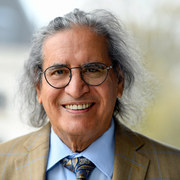LONDON: The media industry has been urged to stop being afraid of artificial intelligence and embrace it by managers of leading Arabic news website Elaph as it prepares to launch a new AI-augmented service.
Caledonia Edmond, the head of partnerships at London-based Elaph, told Arab News that AI and journalism will go “hand in hand” in the future.

Caledonia Edmond, head of
partnerships at
Elaph.
“I think it will definitely be like a symbiotic relationship with AI and journalism,” said Edmond.
She asserted that AI would “revolutionize” both how journalists do their work, as well as the relationship between news and audience. “It will help journalists discover what is really going on in the stories (and) will be a good complement to journalism,” she added.
In May, Elaph announced a major investment into AI, making it the first Arabic publication to do so, according to the company.
By adopting AI in its strategy, Elaph’s vision is to enrich users’ news experience through customized, attractive and in-depth content.
Its AI feature Advancia.ai will serve a variety of functions within the publication, said Edmond.
“We’re going to be using it for a lot of different things,” she said. “We want to have more of an immersive experience.”
Advancia was developed as a joint venture between Elaph and Virtual Minds, which specializes in media and digital technologies. Edmond explained that the publication is not only a partner in the venture but also the “proof of concept.”
Advancia’s features include customizable news services, AI-based digital human-like news anchors, and news credibility checks, which are aimed at enabling news organizations to provide personalized, accessible, and credible content to their audiences.
It will also include a ChatGPT-like chatbot designed to provide users with insightful data, the latest updates, and a deeper understanding of specific events, explained Edmond.
For example, the chatbot will allow users to ask questions in order to learn more about current and multifaceted events such as the conflict in Ukraine or the unrest in Syria.
The bot will also be able to translate audio in real time from English to Arabic and vice versa. This feature was particularly time-consuming to develop, requiring a significant amount of research, but the results have been rewarding, said Edmond.
“AI has had a problem with translating from English to Arabic,” she said. But new innovations such as making the AI voice sound more natural and human-like have resulted in positive internal tests, indicating that the technology is just about “where it should be,” she added.
Although Elaph might be the first Arabic publication to heavily invest in AI, other global media houses like The New York Times and Financial Times have already invested in the technology.
Elaph hopes to learn from other media organizations, not copy them, said Othman Al-Omair, founder and editor-in-chief of Elaph.
Still, “nobody has the experience” as everyone “started at the same time,” he said.

Othman Al-Omair, founder and
editor-in-chief of
Elaph.
Elaph seems ambitious to take this inspiration and build on it further. “We want to get a little bit more advanced,” said Edmond. “We want to have an AI (experience) more tailored to each individual who’s reading or watching the content.”
Despite AI’s growing adoption, concerns have been apparent, particularly in news media where AI can generate false information and images more easily than humans.
Al-Omair, however, remains confident.
He said: “Yes, there is the bad side of it, which is fake stories and fake pictures, but in the future people will get used to it and they will find the right way to use it.”
Elaph’s adoption of AI is part of a larger strategy that includes attracting younger audiences. Edmond expects the younger, tech-savvy audiences to gravitate toward the new offerings first, with the rest of the readers adopting it over a longer period of time.
The paper also plans to ramp up its social media strategy and “grab young kids’ attention,” she added.
“We’re going to reach out to the young people (on social media) and have them start creating content and then featuring it,” said Edmond.
Elaph is not only aiming to expand its reach to a younger audience, but also a wider geography.
It plans to publish in other languages such as Hebrew and Kurdish as well as cater to “minorities like Amazighs (Berbers) in Morocco,” Al-Omair said.
“This is one of the fields which (has) been neglected by media,” he added.
Elaph’s AI technology has been in development for a long spell and the time is “finally” right, said Al-Omair.
Setting aside concerns about the dangers of AI, Edmond said, AI would serve as a powerful ally for journalists, enabling them to swiftly analyze vast data sets, pinpoint inaccuracies, and verify facts, which, in turn, will lead to more accurate information that will reinforce journalistic integrity.














